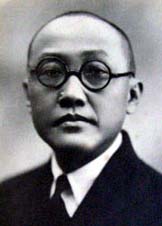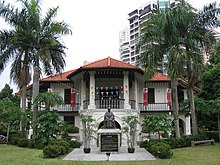Lee Choon Seng

Lee Choon Seng (
Early years and personal life
In 1888, Lee was born in
Business
Lee moved to Singapore to set up another branch of his family business, called Thye Hin Limited. In Singapore, he founded Eng Hin Company, the Thye Hong Biscuit Factory and Thye Ann Investment, a property firm.
Contributions to the Chinese community
Support of Sun Yat Sen

An ardent supporter of the
Chinese community organisations
From 1927, Lee was actively involved with the SCCCI, initially as General-Secretary, then as President.
Contributions to Buddhism in Singapore
Poh Ern Shih Temple
During
Singapore Buddhist Lodge
In 1943, the Singapore Buddhist Lodge (Chinese: 新加坡佛教居士林; Pe̍h-ōe-jī: Sin-ka-pho Hu̍t-kàu Ku-sū-lîm) was set up with about 100 members, mostly from the Chinese social elite. Its fixed address, a double-storey house at 26 Blair Road, was donated by Lee, who also contributed S$1,000 for furniture and other expenses, a considerable sum at that time.[10] The Lodge grew to over 2000 members by 1946, so Zhang Jiamei and Zhong Tianshui decided to rent bigger premises at 17 Kim Yam Road. In 1950, Zhang and Lee donated S$10,000 and started a drive to raise funds to purchase the rented premises.[18]
Singapore Buddhist Federation
The rate of growth of Buddhist temples and Buddhists doubled after the war, but without an umbrella organisation, each temple, headed by a chief monk or management committee, had its own way of conducting its affairs and relied on itself for financial support. Lee invited representatives from all Chinese temples to the Singapore Buddhist Lodge to discuss the formation of an umbrella organisation, and on 30 October 1949, the
The Chinese Temple in Sarnath
In the early 1930s, Lee learned that Venerable Tao Chiai wanted to restore a dilapidated Chinese temple in
Death and commemoration

On 5 June 1966, Lee was found dead in his home at Pasir Panjang Road. On 9 November 2008, his life and contributions to society were commemorated in a gallery, called The Pioneers' Memorial Hall, on the ground floor of the Ee Hoe Hean Club at Bukit Pasoh Road.[1][14]
See also
- Poh Ern Shih Temple
- Hong Choon
- Ho Yuen Hoe
- Teresa Hsu Chih
- Piya Tan
References
Notes
- ^ a b Serene Luo, "Hall of fame for pioneers of finance", The Straits Times, 10 November 2008.
- ^ a b Lee, "Historical data on Lee Choon Seng".
- ^ Lee, "Lee Lip Chai".
- ^ Lee, "Acts of Philanthropy in China".
- ^ Lee, "His Contribution to Buddhism".
- ^ "Leading Singapore banker dies at age 82", The Straits Times, 6 June 1966.
- ^ Lee, "Banker".
- ^ Cui, pp. 138—9.
- ^ Lee, "Supporter of the Kuomintang and Dr Sun Yat Sen".
- ^ a b Ong, "Chinese Mahayana Lay organisations", pp. 49—50.
- ^ "From Villa to Memorial", The Straits Times, 25 February 1995.
- ^ Lee, "Active Role in Singapore Chamber of Commerce".
- ^ Lynn Seah, "SCCCI's Centennial Celebrations", The Sunday Times, 22 October 2006
- ^ a b Information obtained from on-site information board at The Pioneers' Memorial Hall.
- ^ Ong, "Japanese-Occupied Singapore", pp. 64—5.
- ^ Lee, "The Endau Incident during the Japanese Occupation".
- ^ "Poh Ern Shih: History", Poh Ern Shih.
- ^ Ong, "Growth of lay organisations", p. 77.
- ^ a b Ong, "Formation of the Singapore Buddhist Federation", pp. 87—8.
- ^ Lee, "The Chinese Temple in Sarnath".
Bibliography
- Ong, Y.D. (2005). Buddhism in Singapore — A Short Narrative History. Singapore: Skylark Publications. ISBN 981-05-2740-3.
- Lee Boon Siong (2007). "History of Lee Choon Seng"—Poh Ern Shih Heritage Exhibition. Singapore: Poh Ern Shih.
- Cui, Guijang (1994). The Chinese in Singapore: Past and Present. Singapore: Select Books. ISBN 9971-0-0401-1.
